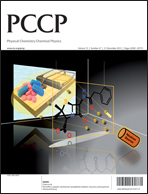Fabrication of high performance/highly functional field-effect transistor devices based on [6]phenacene thin films†
Abstract
Field-effect transistors (FETs) based on [6]phenacene thin films were fabricated with SiO2 and parylene gate dielectrics. These FET devices exhibit field-effect mobility in the saturation regime as high as 7.4 cm2 V−1 s−1, which is one of the highest reported values for organic thin-film FETs. The two- and four-probe mobilities in the linear regime display nearly similar values, suggesting negligible contact resistance at 300 K. FET characteristics were investigated using two-probe and four-probe measurement modes at 50–300 K. The two-probe mobility of the saturation regime can be explained by the multiple shallow trap and release model, while the intrinsic mobility obtained by the four-probe measurement in the linear regime is better explained by the phenomenon of transport with charge carrier scattering at low temperatures. The FET device fabricated with a parylene gate dielectric on polyethylene terephthalate possesses both transparency and flexibility, implying feasibility of practical application of [6]phenacene FETs in flexible/transparent electronics. N-channel FET characteristics were also achieved in the [6]phenacene thin-film FETs using metals that possess a small work function for use as source/drain electrodes.
![Graphical abstract: Fabrication of high performance/highly functional field-effect transistor devices based on [6]phenacene thin films](/en/Image/Get?imageInfo.ImageType=GA&imageInfo.ImageIdentifier.ManuscriptID=C3CP53598C&imageInfo.ImageIdentifier.Year=2013)

 Please wait while we load your content...
Please wait while we load your content...